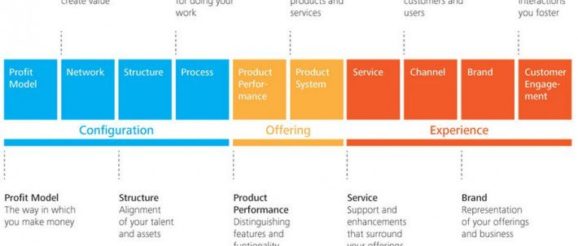The Ten Types of Innovation Framework – and How to Use It

Innovation tends to focus around product performance – new products, new updates, new features. That’s why companies often think of R&D investment as the ingredient for innovation. But there’s plenty of innovation to be had in the areas that surround the product. By looking at successful innovators, we can see that they are adept at finding breakthroughs in these surrounding areas. The Ten Types of Innovation is a methodology that is particularly useful at helping us think more broadly, let’s take a look at how it works.
Since the late 90’s, the Doblin group has been working with the Ten Types framework, led by Larry Keeley. Doblin is now part of Deloitte, and the framework has been encapsulated into a book, The Ten Types of Innovation: The Discipline of Building Breakthroughs. The ten types are split into three areas. At the center is the Offering, which contains the core product elements, and how the product is organized and integrated. To the left is Configuration, how the company is organized to make a profit. And to the right is the Experience, how the company interacts with the customer. Let’s look at each of the elements in detail.
Profit Model
Network
Structure
Process
Product Performance
Product System
Service
Channel
Brand
Customer Engagement
Combinations of types are most powerful
When a company works to combine multiple types of innovations, they often produce powerful results. The authors of the book studied companies considered innovative in 2011, grouping them into average and top innovators, and found that top innovators (those repeatedly launching successful offerings) were integrating twice as many types of innovation as the average innovators.
(Source: Ten Types of Innovation)
(Source: Ten Types of Innovation)
Compared to the S&P 500, companies that integrated multiple types of innovations were more successful over a period of time. You can see clearly the results of those companies with five or more of the ten types.
(Source: Ten Types of Innovation)
Nike Example
A Product Performance company at its core, Nike has made leading sportswear and equipment for decades. In 1985 they made a remarkable innovation, by signing then rookie basketball star Michael Jordan to endorse the Nike brand. This trend of sportstar endorsements continues strongly today, to help the likes of Nike and Adidas maintain market dominance.
In 1990, Niketown was launched – a Channel innovation, to present ‘retail as theatre’. The flagship stores cost millions, and were clearly never going to produce a return on investment by selling goods in store. Instead the initiative was funded by the advertising budget; the stores could do more to build Brand innovation than any ad campaign.
In recent times Nike has launched Nike+, a leading Product System which is integrated into the sportswear range, and allows runners and athletes to track their movements. It also integrated with Apple products in a Network innovation. These steps alone touch on half of the ten types, and as a result Nike is consistently one of the leading brand names in the world.
Method Example
Founded in 2000, Method is a design and sustainability conscious home care products company. In 2012 they were acquired by Ecover to form the world’s “largest green cleaning company.” The products kill germs, but are produced without the use of toxic chemicals. Method follows a Process called greensourcing, which tracks the environmental impact of making its products, and it outsources production to many subcontractors to keep the company agile and nimble (Structure).
The Brand is built around the values of greensourcing, and has built a strong following among design and lifestyle blogs, with the packaging created by industrial designer Karim Rashid. Method has a community site called People Against Dirty, which offers deals, stories, and insights to future products. The movement brings in people who are more broadly supportive for environmental sustainability, as well as developing Customer Engagement. With its core Product Performance offering, Method innovates around half of the ten types like Nike.
Ten Types Idea Campaigns
If you’re stuck getting ideas beyond product performance, you could launch a series of idea campaigns to tackle different aspects of the ten types. If you really want to push for diverse thinking, imagine running ten campaigns to gather input on the full spectrum. While R&D is the typical audience for product innovations, consider how useful HR would be for thinking through Structure innovations; Sales and Finance for Profit Model innovations; Marketing for Brand and Customer Engagement innovations.
The ten types enable you to structure the thinking, and focus collaborative participation on one particular area – this focus, as always, can help produce high quality ideas. The framework is easy to understand and communicate, and therefore a useful way to engage your audience.
The book also includes ‘innovation tactics’, which are small sources of inspiration to generate new thinking under each of the ten types. For example, here are a few tactics listed under Profit Model:
There are hundreds of tactics listed on the ten types website, you can also purchase a deck of cards representing the tactics, which are helpful for running a workshop around the framework. If you’re running idea campaigns, you could add the tactics into your inspiration spaces, or as seed ideas to a campaign, to provide food for thought for your community.
One of the best uses of the framework is to help engage the entire business in thinking through innovation possibilities, as Larry Keeley puts it:
Also check out these posts:
